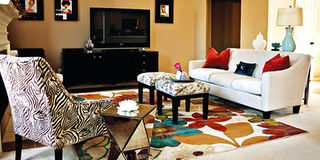Playing with pattern

What you need to know:
- Get creative: If you are not willing to risk the unusual, you will have to settle for the ordinary. If you have a bland space that needs spicing up, try the time-tested route of patterns on furniture, carpets walls...
Including print in one’s décor is one of those ideas that many people find difficult to embrace; if anything they would not even dream of coming within a 10-metre radius of the idea, let alone the patterns themselves.
And I understand their inhibitions; you are never quite sure how to bring them into play without looking as though you are trying too hard to get out of your comfort zone, or without the result being visually disturbing.
So you choose to stick to the solid and possibly bold colours you have grown to love (note that five years ago, this was not the case scenario, but hey…) and hope your interiors will still be eye-catching enough. Those who try limit them to throw pillows and other small areas where the room for error is minimal.
Motivational speaker Jim Rohn once said: “If you are not willing to risk the unusual, you will have to settle for the ordinary”, and that is exactly how I feel about patterns.
They give you an opportunity to create a vibrant space full of movement and visual interest with a definite lasting impact, but if you choose not to take the risk and add them to your space, then you might have to settle for ordinary. But who really wants ordinary?
Now that you know what the basic categories are and that even within those categories there is variety, your failure to find something you like is a pretty lame excuse.
With the kind of variety that is available, there is something for the bold, the eccentric, those looking for elegance, and those who just want to take baby steps in the direction of using prints in their home.
So how do you find the right print for your space? Do you just pick a print and copy paste it on every available space, then pat yourself on the back for daring to take the leap?
Obviously not. First, evaluate your space and look at the existing patterns in your architectural details and pick patterns that will either mirror them or contrast with them.
If you are just beginning to venture into the world of patterns, my suggestion would be to mirror it as it is easier to achieve a harmonious result.
If you have window grills that resemble vines, go for a vine-like pattern on your fabrics. Exposed brick? Go geometric.
Next, consider the size of your space and the scale of your print; the rule of thumb is that smaller spaces handle small prints better while the larger a space is, the larger a pattern it can handle.
This rule can be broken and still give great results, but it can easily go wrong, with the result being an overwhelmed space. Understanding how the eye perceives pattern will also go a long way in making the right choice: Vertical lines visually add height to a room with a low ceiling, while horizontal lines add visual space or width to an area.
Now that you have found a print that you are sure you are comfortable with and works for your space, what next? Do you use it by itself and hope it does not get monotonous?
My suggestion? Mix your patterns. Going for one specific pattern alone will easily swing from monotonous to overwhelming, both of which are not good results, but mixing patterns allows you to create a dynamic space that looks like some thought was put into the design.
Here are a few guidelines that will make mixing patterns (which people often avoid like the plague) a walk in the park.
Pick patterns within the same category: If you have picked an organic print, maybe florals, pick another organic print that varies from your first choice in terms of size or form. Because they are from the same category, they will easily complement each other and provide flow.
Choose patterns with contrasting densities (density refers to how tightly grouped the elements of the pattern are). If your floral print, for example, is “tight”, your complementary print should be less dense.
Have a similar colour in each piece of fabric with a different pattern.
If you are just starting out, limit your patterns to three.
If you are looking for something to spice up your space, probably because it is bland, lacks character or simply because you feel it needs some extra pizzazz, forget about getting bold colours to liven up your space (that route has been overdone), go for pattern; it will do the job just right.




